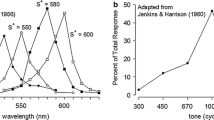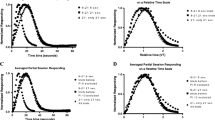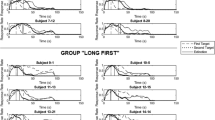Abstract
In this study, the authors developed a fundamental theory of interval timing behaviour, inspired by the learning-to-time (LeT) model and the scalar expectancy theory (SET) model, and based on quantitative analyses of such timing behaviour. Our experiments used the peak-interval procedure with rats. The proposed model of timing behaviour comprises clocks, a regulator, a mixer, a response, and memory. Using our model, we calculated the basic clock speeds indicated by the subjects’ behaviour under such peak procedures. In this model, the scalar property can be defined as a kind of transposition, which can then be measured quantitatively. The Akaike information criterion (AIC) values indicated that the current model fit the data slightly better than did the SET model. Our model may therefore provide a useful addition to SET for the analysis of timing behaviour.














Similar content being viewed by others
Notes
Abbreviations. FI schedule, fixed interval schedule; PI procedure, peak-interval procedure.
Abbreviations. SET, the scalar expectancy theory; LeT model, the learning-to-time model.
Abbreviation. BeT, the behavioural theory-of-timing model.
Abbreviation. PD, Poisson decomposition.
Abbreviation. ITI, intertrial interval.
Abbreviation. AIC, the Akaike information criterion.
References
Akaike, H. (1974). A new look at the statistical model identification. IEEE Transaction Automatic Control, 19, 716–723.
Allman, M.J., Teki, S., Griffiths, T.D., Meck, W.H (2014). Properties of the internal clock: First- and second-order principles of subjective time. Annual Review of Psychology, 65, 743–771.
Alper, J.S., & Bridger, M. (1997). Mathematics, models and Zeno’s paradoxes. Synthese, 110, 143–166.
Beckmann, J.S., & Young, M.E (2009). Stimulus dynamics and temporal discrimination: Implications for pacemakers. Journal of Experimental Psychology: Animal Behavior Processes, 35, 525–537.
Buhusi, C.V., & Meck, W.H. (2005). What makes us tick? Functional and neural mechanisms of interval timing. Nature Reviews Neuroscience, 6(10), 755–765.
Cheng, R.K., & Meck, W.H (2007). Prenatal choline supplementation increases sensitivity to time by reducing non-scalar sources of variance in adult temporal processing. Brain Research, 1186, 242–254.
Church, R.M. (1984). Properties of the internal clock. Annals of The New York Academy of Sciences, 423, 566–582.
Church, R.M., Miller, K.D., Meck, W.H., Gibbon, J. (1991). Symmetrical and asymmetrical sources of variance in temporal generalization. Animal Learning & Behavior, 19, 207–214.
Church, R.M. (2003). A concise introduction to scalar timing theory. In: W. H. Meck (Ed.) In Functional and Neural Mechanisms of Interval Timing, Methods & New Frontiers in Neuroscience. CRCPress LLC, Boca Raton, Florida, (pp. 3–22).
Clément, A., & Droit-Volet, S. (2006). Counting in a time discrimination task in children and adults. Behavioural Processes, 71, 164–171.
Dayan, P., & Abbott, L.F. (2001). Theoretical Neuroscience: Computational and Mathematical Modeling of Neural Systems. Cambridge, Massachusetts: MIT Press.
Fetterman, J.G., & Killeen, P.R. (1991). Adjusting the pacemaker. Learning and Motivation, 22, 226–252.
Fetterman, J.G., Killeen, P.R., Hall, S. (1998). Watching the clock. Behavioural Processes, 44, 211–224.
Gibbon, J. (1977). Scalar expectancy theory and Weber’s law in animal timing. Psychological Review, 84, 279–325.
Gibbon, J., Church, R.M., Meck, W.H (1984). Scalar timing in memory. Annals of The New York Academy of Sciences, 423, 52–77.
Grondin, S. (2001). From physical time to the first and second moments of psychological time. Psychological Bulletin, 127, 22–44.
Killeen, P.R. (1975). On the temporal control of behavior. Psychological Review, 82, 89–115.
Killeen, P.R., & Fetterman, J.G. (1988). A behavioral theory of timing. Psychological Review, 95, 274–295.
Killeen, P.R., & Taylor, T.J. (2000). How the propagation of error through stochastic counters affects time discrimination and other psychophysical judgments. Psychological Review, 107, 430–459.
Kirkpatrick-Steger, K., Miller, S., Betti, C., Wasserman, E. (1996). Cyclic responding by pigeons on the peak timing procedure. Journal of Experimental Psychology: Animal Behavior Processes, 22, 447–460.
McAuley, J.D., Miller, J.P., Pang, K.C.H. (2006). Modeling the effects of the NMDA receptor antagonist MK-801 on timing in rats. Behavioral Neuroscience, 120, 1163–1168.
Machado, A. (1997). Learning the temporal dynamics of behavior. Psychological Review, 104, 241–265.
Machado, A., & Guilhardi, P. (2000). Shifts in the psychometric function and their implications for models of timing. Journal of The Experimental Analysis of Behavior, 74, 25–54.
Matell, M.S., & Meck, W.H (1999). Reinforcement-induced within-trial resetting of an internal clock. Behavioural Processes, 45, 159–171.
Matell, M.S., Meck, W.H., Nicolelis, M.A.L. (2003). Interval timing and the encoding of signal duration by ensembles of cortical and striatal neurons. Behavioral Neuroscience, 117, 760–773.
Mazur, J.E. (2006). Learning and Behavior, 6th ed. NJ: Prentice Hall.
Meck, W.H. (1996). Neuropharmacology of timing and time perception. Cognitive Brain Research, 3, 227–242.
Meck, W.H. (2006). Neuroanatomical localization of an internal clock: a functional link between mesolimbic, nigrostriatal, and mesocortical dopaminergic systems. Brain Research, 1109, 93–107.
Oprisan, S.A., & Buhusi, C.V. (2011). Modeling pharmacological clock and memory patterns of interval timing in a striatal beat-frequency model with realistic, noisy neurons. Frontiers in Integrative Neuroscience, 5, 52.
Oprisan, S.A., & Buhusi, C.V (2013). Why noise is useful in functional and neural mechanisms of interval timing?. BMC Neuroscience, 14, 84.
Roberts, S. (1981). Isolation of an internal clock. Journal of Experimental Psychology: Animal Behavior Processes, 7, 242–268.
Saigusa, T., Tero, A., Nakagaki, T., Kuramoto, Y. (2008). Amoebae anticipate periodic events. Physical Review Letters, 100(1), 018101.
Spence, K.W. (1937). The differential response in animals to stimuli varying within a single dimension. Psychological Review, 44, 430–444.
Staddon, J.E.R., & Higa, J.J. (1999). Time and memory: Towards a pacemaker-free theory of interval timing. Journal of The Experimental Analysis of Behavior, 71, 215–251.
Vlastos, G. (1967). Zeno of Elea. In: The Encyclopedia of Philosophy, 8. Macmillan, New York, (pp. 369–379).
Yi, L. (2007). Applications of timing theories to a peak procedure. Behavioural Processes, 75, 188–198.
Zentall, T. (2006). Timing, memory for intervals, and memory for untimed stimuli: The role of instructional ambiguity. Behavioural Processes, 71, 88–97.
Acknowledgments
The authors wish to thank Hiromi Ohtake, Ryo Kobayashi, and Hiroshi Tango for their comments regarding the mathematics, Ken’ichiro Shimatani for his comments regarding the statistics, Simon Fraser and Anne Macaskill for their comments regarding written English, and Asako Ujita for her assistance with the experiment. The authors also thank Takayuki Sakagami and Peter Killeen for their valuable advice about behavioural sciences.
Conflict of interests
The authors declare that they have no conflict of interest
Author information
Authors and Affiliations
Corresponding author
Additional information
Action Editor: Mark van Rossum
Appendix
Appendix
The mean value of the correlation coefficients
For each correlation coefficient r, after normalization by Fisher’s z′ transformation (r-to- z′ transformation) \(z^{\prime } = \frac {\,1\,}{\,2\,}\ln \frac {\,1 + r\,}{\,1 - r\,}\), we calculated the arithmetic mean \(\overline {z^{\prime }}\) of z′. Then we converted back to get the mean \(\overline {r}\) shown in all panels in Figs. 10 and 14.
Rights and permissions
About this article
Cite this article
Hasegawa, T., Sakata, S. A model of multisecond timing behaviour under peak-interval procedures. J Comput Neurosci 38, 301–313 (2015). https://doi.org/10.1007/s10827-014-0542-4
Received:
Revised:
Accepted:
Published:
Issue Date:
DOI: https://doi.org/10.1007/s10827-014-0542-4




